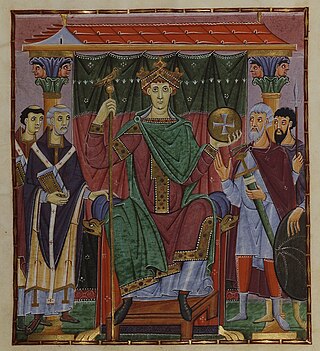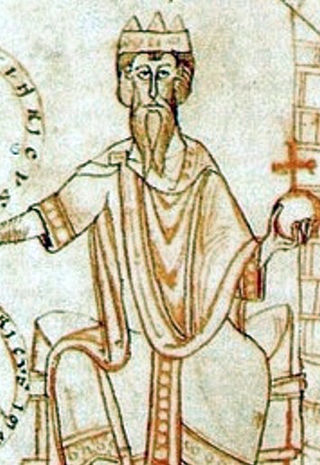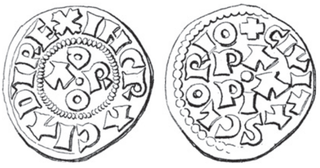Related Research Articles

Year 1002 (MII) was a common year starting on Thursday of the Julian calendar.

Year 1004 (MIV) was a leap year starting on Saturday of the Julian calendar.

Otto III was Holy Roman Emperor from 996 until his death in 1002. A member of the Ottonian dynasty, Otto III was the only son of the Emperor Otto II and his wife Theophanu.

Otto II, called the Red, was Holy Roman Emperor from 973 until his death in 983. A member of the Ottonian dynasty, Otto II was the youngest and sole surviving son of Otto the Great and Adelaide of Italy.

Conrad II, also known as Conrad the Elder and Conrad the Salic, was the emperor of the Holy Roman Empire from 1027 until his death in 1039. The first of a succession of four Salian emperors, who reigned for one century until 1125, Conrad ruled the kingdoms of Germany, Italy and Burgundy.

King of Italy was the title given to the ruler of the Kingdom of Italy after the fall of the Western Roman Empire. The first to take the title was Odoacer, a barbarian warlord, in the late 5th century, followed by the Ostrogothic kings up to the mid-6th century. With the Frankish conquest of Italy in the 8th century, the Carolingians assumed the title, which was maintained by subsequent Holy Roman Emperors throughout the Middle Ages. The last Emperor to claim the title was Charles V in the 16th century. During this period, the holders of the title were crowned with the Iron Crown of Lombardy.
John XVI was an antipope from 997 to 998.

Berengar I was the king of Italy from 887. He was Holy Roman Emperor between 915 and his death in 924. He is usually known as Berengar of Friuli, since he ruled the March of Friuli from 874 until at least 890, but he had lost control of the region by 896.

Lambert was the King of Italy from 891, Holy Roman Emperor, co-ruling with his father from 892, and Duke of Spoleto and Camerino from his father's death in 894. He was the son of Guy III of Spoleto and Ageltrude, born in San Rufino. He was the last ruler to issue a capitulary in the Carolingian tradition.

Berengar II was the King of Italy from 950 until his deposition in 961. He was a scion of the Anscarid and Unruoching dynasties, and was named after his maternal grandfather, Berengar I. He succeeded his father as Margrave of Ivrea around 923, and after 940 led the aristocratic opposition to kings Hugh and Lothair II. In 950 he succeeded the latter and had his son, Adalbert crowned as his co-ruler. In 952 he recognised the suzerainty of Otto I of Germany, but he later joined a revolt against him. In 960 he invaded the Papal States, and the next year his kingdom was conquered by Otto. Berengar remained at large until his surrender in 964. He died imprisoned in Germany two years later.

Conrad II of Italy, also known as Conrad (III) (12 February 1074 – 27 July 1101), was the Duke of Lower Lorraine (1076–1087), King of Germany (1087–1098) and King of Italy (1093–1098). He was the second son of Holy Roman Emperor Henry IV and Bertha of Savoy, and their eldest son to reach adulthood, his older brother Henry having been born and died in the same month of August 1071. Conrad's rule in Lorraine and Germany was nominal. He spent most of his life in Italy and there he was king in fact as well as in name.

Arduin was an Italian nobleman who was King of Italy from 1002 until 1014.
Arnulf of Milan, or Arnulfus Mediolanensis was a medieval chronicler of events in Northern Italy. He was the great-nephew of Archbishop Arnulf I of Milan.

Adalbert was the king of Italy from 950 until 961, ruling jointly with his father, Berengar II. After their deposition, Adalbert continued to claim the Italian kingdom until his defeat in battle by the forces of Otto I in 965. Since he was the second Adalbert in his family, the Anscarids, he is sometimes numbered Adalbert II. His name is occasionally, especially in older works, shortened to Albert.

The Kingdom of Italy, also called Imperial Italy, was one of the constituent kingdoms of the Holy Roman Empire, along with the kingdoms of Germany, Bohemia, and Burgundy. It originally comprised large parts of northern and central Italy. Its original capital was Pavia until the 11th century.
The March of Ivrea was a large frontier county (march) in the northwest of the medieval Italian kingdom from the late 9th to the early 11th century. Its capital was Ivrea in present-day Piedmont, and it was held by a Burgundian family of margraves called the Anscarids. The march was the primary frontier between Italy and Upper Burgundy and served as a defense against any interference from that state.

Otto I, traditionally known as Otto the Great, or Otto of Saxony, was East Frankish king from 936 and Holy Roman Emperor from 962 until his death in 973. He was the eldest son of Henry the Fowler and Matilda of Ringelheim.

Henry II, also known as Saint Henry the Exuberant, Obl. S. B., was Holy Roman Emperor from 1014. He died without an heir in 1024, and was the last ruler of the Ottonian line. As Duke of Bavaria, appointed in 995, Henry became King of the Romans following the sudden death of his second cousin, Emperor Otto III in 1002, was made King of Italy in 1004, and crowned emperor by Pope Benedict VIII in 1014.

The monarchy of Italy was the system of government in which a hereditary constitutional monarch was the sovereign of the Kingdom of Italy from 1861 to 1946.
References
- Savio F., Gli antichi vescovi d'Italia. 2. Lombardia – 1 Milano, Firenze 1913.
- Beretta E., Note sulla famiglia dell'arcivescovo Arnolfo II d'Arsago (sec. VIII-XI), Archivio ambrosiano 33 (1977).